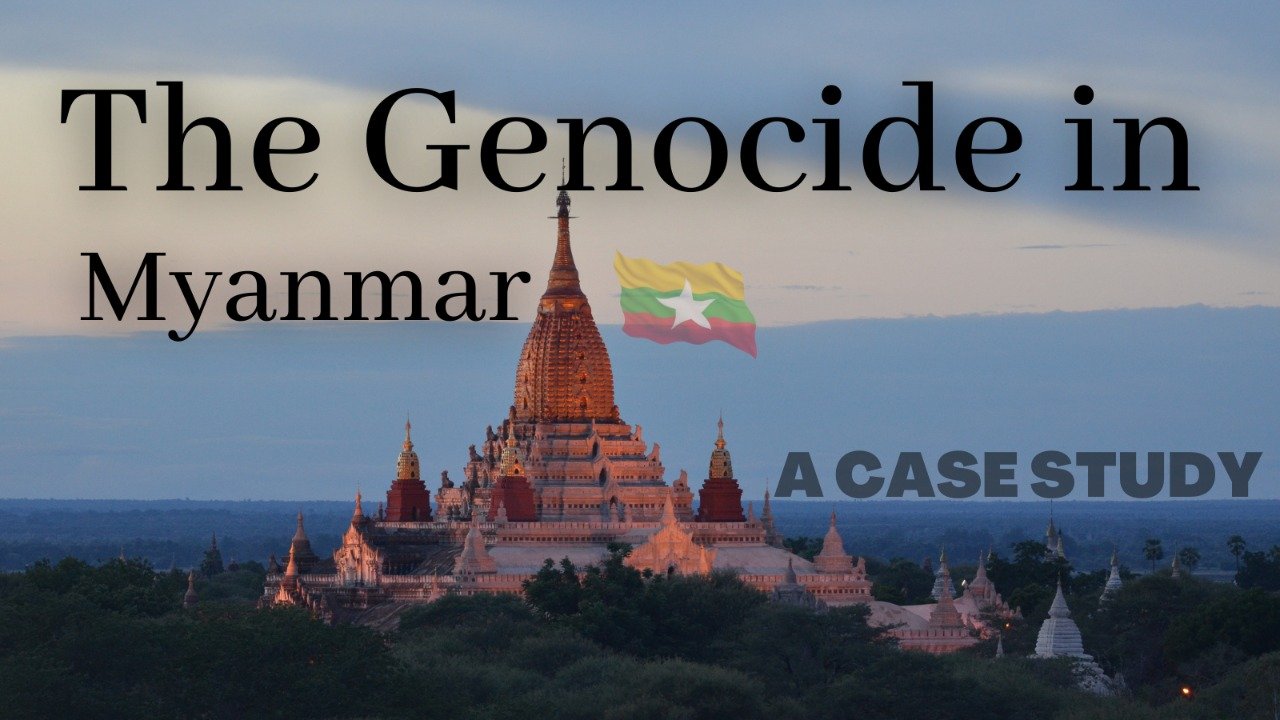THE GENOCIDE IN MYANMAR: A CASE STUDY

Article II of the 1948 Genocide Convention defines genocide as any act committed with the intent to exterminate "a national, ethnic, racial, or religious group, in whole or in part." The UN considers the following acts to be genocide:
-
The assassination of a group member.
-
Causing serious bodily or mental harm to a group member.
-
Inflicting on the group conditions of life that are designed to cause its physical destruction, in whole or in part.
-
Imposing measures aimed at preventing births within groups.
-
Children from one group are being forced to transfer to another.
Genocide and other crimes against humanity are actions that endanger the welfare of all states. Myanmar, India's eastern neighbor, is facing an indistinguishable situation of mass genocide against Rohingya Muslims. From 1962 to 2011, an oppressive military junta ruled Myanmar. The regimes were responsible for major human rights violations against ethnic and religious minority groups in this country, where Buddhism is the majority religion. Two-thirds of the population is Bamar, but there are at least 135 ethnic minority groups in the country. The government and military are controlled by the Burman majority. As a result, many minority groups have been pushed to the country's outskirts, where natural resources are scarce, access to education and social programs is limited, and participation in the country's decision-making process is non-existent. Many people accuse Myanmar's government of "ethnic cleansing" because of mass atrocities committed against the Rohingya, including summary executions, severe torture, rape, forced labor, extortion, and displacement. Aid agencies estimated that over 200,000 of them had been displaced from their homes during decades of conflict up until 2004.
After 2011 when The National League for Democracy (NLD) government came to power in Myanmar, it showed a positive light to resolve the genocide issue in Myanmar. But the government struggle to deliver on its promise of ‘change’ since it swept into office with a landslide victory in the 2015 elections. But here is the question, who are these ethnic minorities who have been discriminated against by the Government of Myanmar, The Rohingya are an ethnic Muslim group who follow a Sufi-inflected form of Sunni Islam. The Rohingya have been present in the former Arakan Kingdom since the fifteenth century when thousands of Muslims arrived. Many more arrived during the nineteenth and early twentieth centuries when Rakhine was governed as part of British India. There are an estimated 3.5 million Rohingya refugees scattered around the world. Before August 2017, the majority of Myanmar's estimated one million Rohingya lived in Rakhine State, where they made up a third of the population. They are ethnically, linguistically, and religiously distinct from Myanmar's dominant Buddhist groups.
Because the Myanmar government has refused to grant citizenship to Rohingya, they lack legal documentation and are effectively stateless. Until recently, the Rohingya could register as temporary residents and obtain identification cards known as white cards. These white cards granted only limited rights and were not accepted as proof of citizenship. The government has recently forced Rohingya to carry national verification cards, which effectively identify them as foreigners but do not grant them citizenship. The Myanmar government has effectively institutionalized discrimination against ethnic groups through restrictions on marriage, family planning, employment, education, religious choice, and freedom of movement.
There is clear evidence of atrocities committed against Rohingyas by the army during its "area clearance operation" in Northern Rakhine State in 2017, which heightens the demand for justice. According to Amnesty International, "these crimes amount to a crime against humanity under international law, as they were perpetrated as part of a widespread and systematic attack against Rohingya."
There are three distinct but related aspects to the Rohingya crisis, none of which appeared to be resolved in 2018. The first issue is accountability. The Myanmar government has categorically rejected all international efforts to investigate alleged human rights violations or prosecute perpetrators, instead presenting its own Independent Commission of Inquiry as a more appropriate alternative. However, the purpose of this commission does not appear to be accountability in the traditional sense, at least not in the legal or retributive sense.
INTERNATIONAL RESPONSE
In August 2018, UN investigators published a report accusing Myanmar's military of carrying out mass killings and rapes with "genocide intent." When Aung San Suu Kyi appeared in court in December 2019, she denied the charge of genocide. But in January 2020, the court's initial ruling ordered Myanmar to take emergency measures to protect the Rohingya from being persecuted and killed.
While the International Court of Justice (ICJ) only hears disputes between states, the International Criminal Court (ICC) can try individuals accused of war crimes or crimes against humanity. In November, the body approved a full investigation into the Rohingya crisis in Myanmar.
Although Myanmar itself is not a member of the court, the ICC ruled it had authority in the case because Bangladesh, where the victims fled, is a member.
CONCLUSION
The 1948 Genocide Convection was an attempt to eliminate the scourge of genocide from the human experience. The prevention and punishment of the crime of genocide, though much work remains, prevention of this extent is important. It is been hoped by the countries that Myanmar will look into this and resolve the genocide issue and grant citizenship to all the Rohingya.
AUTHOR - SATYANSHU KUMARI













